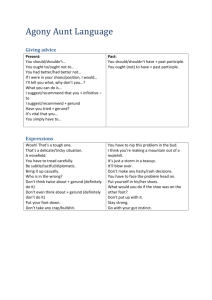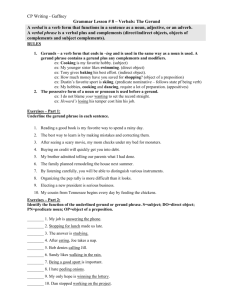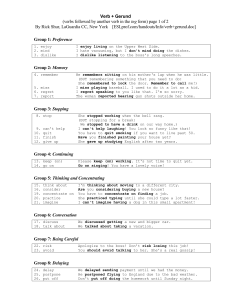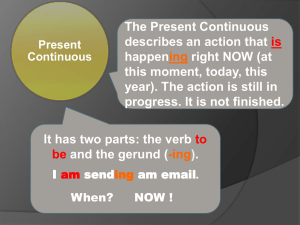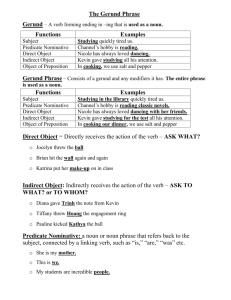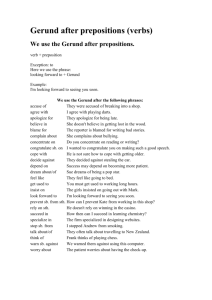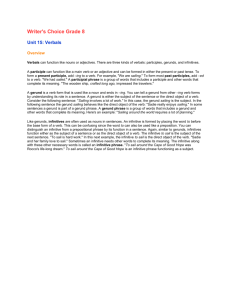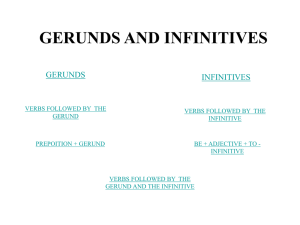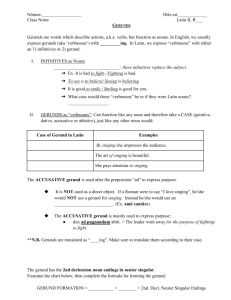GERUNDS - Tacoma Community College
advertisement
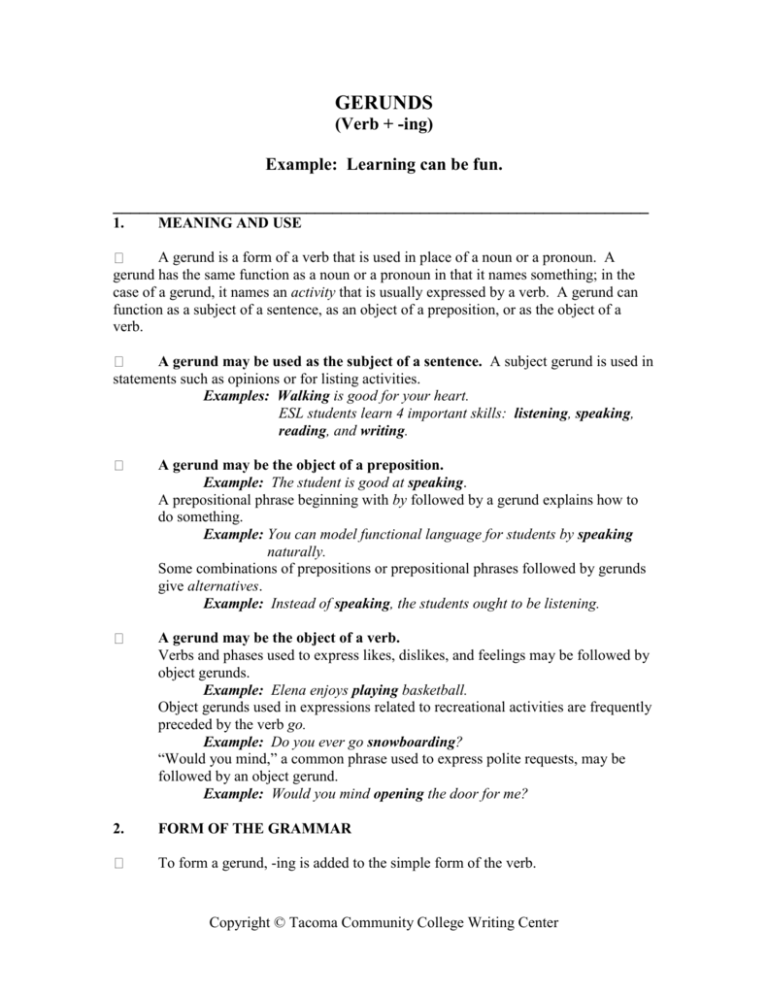
GERUNDS (Verb + -ing) Example: Learning can be fun. _____________________________________________________________ 1. MEANING AND USE A gerund is a form of a verb that is used in place of a noun or a pronoun. A gerund has the same function as a noun or a pronoun in that it names something; in the case of a gerund, it names an activity that is usually expressed by a verb. A gerund can function as a subject of a sentence, as an object of a preposition, or as the object of a verb. A gerund may be used as the subject of a sentence. A subject gerund is used in statements such as opinions or for listing activities. Examples: Walking is good for your heart. ESL students learn 4 important skills: listening, speaking, reading, and writing. A gerund may be the object of a preposition. Example: The student is good at speaking. A prepositional phrase beginning with by followed by a gerund explains how to do something. Example: You can model functional language for students by speaking naturally. Some combinations of prepositions or prepositional phrases followed by gerunds give alternatives. Example: Instead of speaking, the students ought to be listening. A gerund may be the object of a verb. Verbs and phases used to express likes, dislikes, and feelings may be followed by object gerunds. Example: Elena enjoys playing basketball. Object gerunds used in expressions related to recreational activities are frequently preceded by the verb go. Example: Do you ever go snowboarding? “Would you mind,” a common phrase used to express polite requests, may be followed by an object gerund. Example: Would you mind opening the door for me? 2. FORM OF THE GRAMMAR To form a gerund, -ing is added to the simple form of the verb. Copyright © Tacoma Community College Writing Center Example: talk + ing = talking Certain spelling rules must be followed to form gerunds: a. For most verbs, a gerund is formed by adding –ing to the simple form of the verb. Examples: walk – walking, read – reading b. If the simple form of the verb ends in a single “e,” a gerund is formed by dropping the “e” and adding –ing. Examples: exercise – exercising, drive – driving c. If the simple form of the verb ends in “ie,” a gerund is formed by changing the “ie” to “y” and adding –ing. Examples: tie – tying, vie – vying d. If the simple form of a one-syllable verb ends with a single vowel + consonant, a gerund is formed by doubling the final consonant and adding –ing. Examples: shop – shopping, swim – swimming e. If the simple form of a verb with 2 or more syllables ends in a single vowel + consonant, a gerund is formed by doubling the final consonant only if the stress is on the final syllable. Examples: commit – committing (stress is on second syllable), combat – combating (stress is on first syllable) Note: The final “l” is doubled in British English (travel – travelling), but not in American English (travel – traveling). f. If the simple form of the verb ends in “x,” “w,” or “z,” the final consonant is not doubled when adding –ing. Examples: box – boxing, tow – towing, fly – flying A gerund can be one word or a phrase. Examples: I enjoy swimming. I don’t enjoy painting my house. A gerund is always singular and acts like a noncount noun. A gerund takes a singular verb and can be replaced by the pronoun it. Example: I enjoy swimming. I enjoy it. A gerund can be positive or negative; a negative gerund is formed by adding the word not before the gerund. Example: Not walking every day would be unhealthy for me. Many verbs are followed by gerunds, but may not be followed by infinitives (such as appreciate, avoid, consider, delay, deny, dislike, enjoy, finish, go, imagine, keep mind) Example: Have you considered taking a vacation when our class ends? Many common verbs with prepositions may be followed by a gerund, but not an infinitive (such as approve of, believe in, look forward to, talk about, think about, worry about). Example: Do you ever think about taking a vacation? Many phrases ending in prepositions are BE + adjective expressions and may be followed by a gerund but not an infinitive. Examples: ESL students are accustomed to learning grammar. The student is nervous about speaking in front of the class. Some prepositions that occur with gerunds are frequently found at the beginning or the ending of a sentence (i.e. after, before, besides, by, in, in addition to, instead of, without). Examples: Before sleeping, I like to have a snack. I will read a book instead of watching TV. Copyright © Tacoma Community College Writing Center 3. POTENTIAL PROBLEMS STUDENTS MAY HAVE Meaning and Use: Students may use an infinitive when they ought to use a gerund or a gerund when they ought to use an infinitive. Examples: (Error) She believes in to exercise regularly. (Correction) She believes in exercising regularly. (Error) He volunteers painting your house. (Correction) He volunteers to paint your house. Form: Students may see the –ing ending of a continuous verb and mistake it for a gerund. Example: (Continuous verb) Elena has been playing basketball since she was in middle school. (Gerund) Playing basketball has been a hobby of Elena’s since middle school. Form: Students may make spelling errors when adding –ing to the verb to form a gerund. Example: (Error) She believes in exerciseing for good health. (Correction) She believes in exercising for good health. Copyright © Tacoma Community College Writing Center
